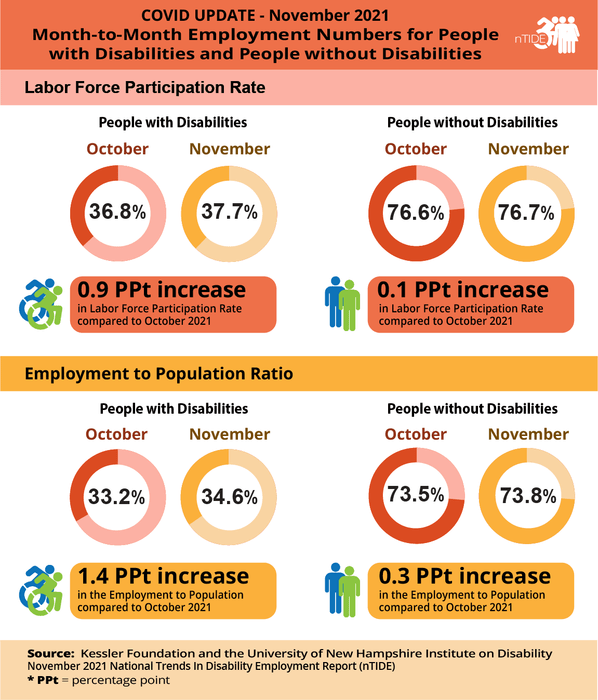November marked the fourth consecutive month of employment gains for people with disabilities, according to the National Trends in Disability Employment – Monthly Update (nTIDE).
This four-month increase is in stark contrast to the declining trend for people without disabilities, according to the report, issued by Kessler Foundation and the University of New Hampshire’s Institute on Disability (UNH-IOD).

nTIDE COVID Update (month-to-month comparison)
In the BLS Jobs Report released recently, the employment-to-population ratio for working-age people with disabilities increased from 33.2% in October 2021 to 34.6% in November 2021 (up 4.2% or 1.4 percentage points). For working-age people without disabilities, the employment-to-population ratio also increased from 73.5% in October 2021 to 73.8% in November 2021 (up 0.4% or 0.3 percentage points).
The employment-to-population ratio, a key indicator, reflects the percentage of people who are working relative to the total population (the number of people working divided by the number of people in the total population multiplied by 100).
“Once again, we are seeing the employment-to-population ratio exceed the historic high points for people with disabilities. Specifically, the November employment-to population-ratio is not only higher than it was before the Covid-19 pandemic but exceeds the all-time recorded high of the fall of 2008.”
— John O’Neill, PhD, director of the Center for Employment and Disability Research at Kessler Foundation
The labor force participation rate for working-age people with disabilities increased from 36.8% in October to 37.7% in November 2021 (up 2.4% or 0.9 percentage points). For working-age people without disabilities, the labor force participation rate also increased from 76.6% in October to 76.7% in November 2021 (up 0.1% or 0.1 percentage points).
The labor force participation rate is the percentage of the population that is working, not working and on temporary layoff, or not working and actively looking for work.
“Seeing both of these indicators—the employment-to-population ratio and labor force participation rate—improving beyond their historic highs, is really positive. These gains suggest that the restructuring resulting from the pandemic may be benefiting people with disabilities. Ironically, it may have taken a pandemic to shake the labor market loose for people with disabilities.”
— Andrew Houtenville, PhD, professor of economics and the research director of the University of New Hampshire’s Institute on Disability
Year-to-Year nTIDE Numbers (comparison to the same time last year)
The employment-to-population ratio for working-age people with disabilities increased from 29.1% in November 2020 to 34.6% in November 2021 (up 18.9% or 5.5 percentage points). For working-age people without disabilities, the employment-to-population ratio also increased from 71.1% in November 2020 to 73.8% in November 2021 (up 3.8% or 2.7 percentage points).
The labor force participation rate for working-age people with disabilities increased from 33.6% in November 2020 to 37.7% in November 2021 (up 12.2% or 4.1 percentage points). For working-age people without disabilities, the labor force participation rate also increased from 75.9% in November 2020 to 76.7% in November 2021 (up 1.1% or 0.8 percentage points).
In November 2021, among workers ages 16-64, the 5,542,000 workers with disabilities represented 3.8% of the total 145,167,000 workers in the US.
[Source(s): Kessler Foundation, EurekAlert]





